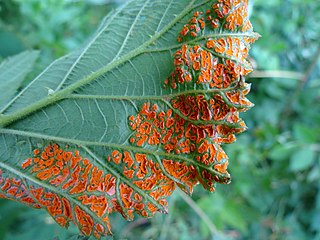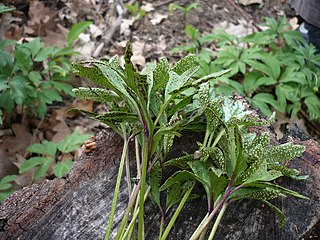MycoBank is an online database, documenting new mycological names and combinations, eventually combined with descriptions and illustrations. It is run by the Westerdijk Fungal Biodiversity Institute in Utrecht.

Arthuriomyces peckianus is a fungal plant pathogen, which causes orange rust on members of the genus Rubus, and various species of berries. It is found in central and eastern North America, and Eurasia.

Gymnoconia nitens is a species of rust fungus in the Phragmidiaceae family. It is a plant pathogen, and causes orange rust on various berries. The species was originally described in 1822 by mycologist Lewis David de Schweinitz as Aecidium luminatum.

Pucciniomycetes is a diverse class of fungi in the subphylum Pucciniomycotina of phylum Basidiomycota. The class contains 5 orders, 21 families, 190 genera, and approximately 8,016 species. It has been estimated that this class contains about one third of all teleomorphic basidiomycetes. Pucciniomycetes contains many economically important plant pathogenic fungal rusts; the order Pucciniales is the largest clade in this class, representing approximately 7,000 species.

The Chaconiaceae are a family of rust fungi in the order Pucciniales. The family contained 8 genera and 75 species in 2008. By 2020, there were 8 genera and 84 species.
The Mikronegeriaceae were a family of rust fungi in the order Pucciniales: now incorporated into the Zaghouaniaceae. The family contained 4 genera and 13 species.

The Phakopsoraceae are a family of rust fungi in the order Pucciniales. The family contains 18 genera and 205 species.

The Phragmidiaceae are a family of rust fungi in the order Pucciniales. The family contains 14 genera and 164 species.

The Pileolariaceae are a family of rust fungi in the order Pucciniales. A 2008 estimate places contains 4 genera and 34 species in the family.
The Pucciniosiraceae are a family of rust fungi in the order Pucciniales. The family contains 10 genera and 57 species.

The Pucciniastraceae are a family of rust fungi in the order Pucciniales. The family contains 11 genera and 158 species.

The Uropyxidaceae are a family of rust fungi in the order Pucciniales. The family contains 15 genera and 149 species.

Frommeella (Frommeëlla) is a genus of rust fungi in the family Phragmidiaceae. The widespread genus contains two species.
Gerwasia is a genus of rust fungi in the family Phragmidiaceae. Species in the genus grow on Rubus and Rosa plants.

Hamaspora is a genus of rust fungi in the family Phragmidiaceae. The genus contains 14 species, which are known from Africa, Asia, and Australia.
The Morispora is a genus of rust fungi in the family Phragmidiaceae. The genus is monotypic, containing the single South American species Morispora tenella.
Scutelliformis is a genus of rust fungi in the family Phragmidiaceae. The genus is monotypic, containing the single species Scutelliformis bicornus.
Trachyspora is a genus of rust fungi in the family Phragmidiaceae. The genus, widespread in northern temperate areas, contains six species.
Chaconia is a genus of rust fungi in the Chaconiaceae family. The widespread genus contains seven species that grow mostly on dicots, especially Leguminosae.

Puccinia mariae-wilsoniae, commonly known as the spring beauty rust, is a species of rust fungus found in North America. A plant pathogen, it grows on the leaves of the spring beauty flowering plants Claytonia caroliniana and C. virginica.













